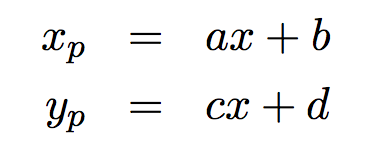From latitude-longitude to positions on images of maps
The maps used to present the locations of disparition of the Malgré Nous during the second World War are extracted from the "Atlas of the World Battle Fronts in Semimonthly phases to August 15 1945". This Atlas was produced for the Chief of Staff of the United States Army in 1945 4.
In this Atlas, the maps used for presenting the war against Germany through November 1944 are based on azimuthal equidistant projection. In this projection, curving latitudes and converging longitudes appear somewhat as they do on a sphere. The maps are drawn such that Berlin corresponds to the origin. The last six months of the war in Europe are shown on enlarged maps with a change of scale from about 250 to 125 miles to the inch.
Consider a location given by its latitude φ and longitude λ. To find its corresponding position (xp, yp) on the image representing a map (where xp and yp are pixel locations), we proceed in two steps:
- Find the plane coordinates (x,y) obtained from the azimuthal equidistant projection
- Transform the coordinates (x,y) into the pixel coordinates (xp, yp).
Step 1: the azimuthal equidistant projection
Let φ1 and λ0 be the latitude and longitude of the center of the projection, respectively. For the maps considered, (φ1,λ0)=(52.52,13.4), i.e. the latitude and longitude of Berlin. Let φ and λ be the latitude and longitude of a point on the sphere representing the Earth. The transformation equations for the azimuthal equidistant projection are given by 5:

with:

and

where c is the angular distance to the center of the projection.
Step 2: Positioning on the maps
The projection described above gives coordinates (x,y) is arbitrary units. To locate those coordinates on the image of a map, we apply linear transformations, namely a scaling and a translation. As such,

The coefficients a, b, c, and d are computed independently for each maps considered. We select two locations (we chose Milan and Minsk). For those two locations, we know their latitudes and longitudes and therefore the corresponding coordinates (x,y). We also find manually their pixel coordinates (xp,yp) for a given map. The coefficients a, b, c, and d are then computed to have the pixel coordinates fit with the planar coordinates, according to the equations above.
Continue to the next section: Resources for Research